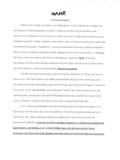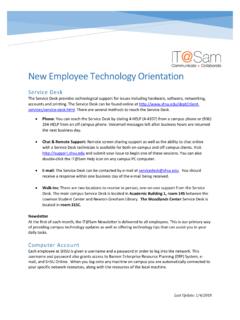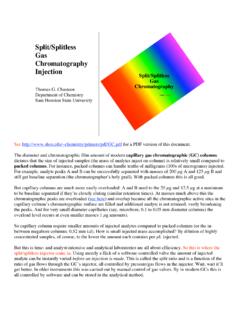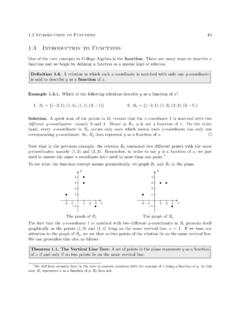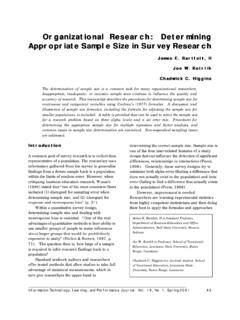Transcription of The impact of Pleasure Reading on Academic Success
1 THE impact OF Pleasure R3 EADING 48 The journal of Multidisciplinary Graduate Research 2016, Volume 2, Article 4, pp. 48-64. The impact of Pleasure Reading on Academic Success Christy Whitten Sam houston State university Sandra Labby Texas A&M university -Texarkana Sam L. Sullivan Sam houston State university Discovering ways to improve student Academic performance is a common challenge in the modern classroom. This research study examined the Reading habits of sixty-five high school juniors, aged fifteen to seventeen years, at a rural Southeast Texas high school. It was theorized that students who engaged in Reading self-selected literature for Pleasure would average higher grades in English, mathematics, science, and history than their non- Reading peers. The authors concluded that students who read for Pleasure averaged higher scores than their non- Reading counterparts in the subject areas measured. The authors further concluded that educators were aware of the link between Pleasure Reading and Academic Success but felt limited by state curriculums and mandated tests.
2 Keywords: Academic achievement, Academic performance, independent Reading , Pleasure Reading The impact of Pleasure Reading on Academic Success A foundation in Reading and writing has been the basis of our educational system since its inception and discovering new ways to increase student interest in those basic components of learning is something that every teacher struggles with at one time or another. Many educators encourage their students to read outside of the classroom in order to increase Reading comprehension, vocabulary, general knowledge, and cultural awareness; however, research indicates that Pleasure Reading may have a greater influence on a child s overall Academic performance than their socio-economic background ( Pearson, 2015). According to Bridges (2014), Many of our revered celebrities and leaders are avid readers. Christy Whitten, Department of Curriculum and Instruction, Sam houston State university ; Sandra Labby, Department of Curriculum and Instruction, Texas A&M university Texarkana; Sam L.
3 Sullivan, Department of Curriculum and Instruction. Correspondence concerning this article should be sent to Sandra Labby, Texas A&M university -Texarkana, 7101 university Ave, SCIT 309B, Texarkana, TX 75503. Email: THE EFFICACY OF PULLOUT 49 Indeed, it s hard to find successful people who aren t (p. 7). Reading opened up worldwide avenues for knowledge that non-readers were unable to access. Recent studies conducted by Kidd and Castano (2013) of The New School for Social Research in New York City, suggested that Pleasure Reading deepened empathy and temporarily allowed the reader a greater understanding of others mental states (Wilhelm & Smith, 2014). In other words, the benefits of Pleasure Reading may have had a much broader impact than previously thought. This study focused on comparing the overall Academic Success of Pleasure readers (sometimes referred to as independent readers) and non- Pleasure readers. According to Cullinan (2000), Pleasure readers at all grade levels whom scored higher on standardized tests in all subject areas, developed greater Reading comprehension skills, had increased fluency, and displayed higher levels of general knowledge.
4 However, in spite of the evidence that Pleasure Reading had a positive impact on student academics, the number of students who read for Pleasure has declined at an alarming rate. According to the National Endowment for the Arts (2007), the percentage of 17-year-olds who read nothing at all for Pleasure has doubled over a 20-year period (p. 7). While the previous studies have focused on national Reading patterns, this study focused on eleventh grade students at a rural Southeast Texas high school. Although there have been studies (Clark & Rumbold, 2006; National Reading Panel, 2000; National Endowment for the Arts, 2007) done on the impact Pleasure Reading has on the overall Academic Success of students, there is a lack of data on the measureable differences in grade averages from specific subjects: English, mathematics, science, and history. This research was needed in order to determine if Pleasure readers experienced increases in grade averages from core subjects, minimal increases in relationship to averages in core subjects, or if Pleasure Reading had no impact on students overall performance in their core subjects.
5 Research Questions The following research questions were used to guide the study. 1. Did 11th grade students at a rural Southeast Texas high school who read for Pleasure maintain higher grade averages than non- Pleasure readers? 2. If Pleasure readers experienced higher grade point averages than non- Pleasure readers, would educators, in all subject areas, be more willing to encourage independent Reading ? Limitations Due to Academic time constraints, this study was restricted to one nine-week grading period. The number of participants who were willing to complete the Reading survey, and who returned their parental consent forms further limited the authors research. Additionally, inquiries aimed to eleventh grade students aged fifteen to seventeen, narrowed the populace assessment. Literature Review Basic Reading According to Clark and Rumbold (2006), Reading for Pleasure was defined as Reading done in THE EFFICACY OF PULLOUT 50 anticipation of the satisfaction it would bring or continuing required Reading because the reader found the subject matter interesting.
6 Pleasure Reading is a personal experience that typically involves materials that reflect our own choice, at a time and place that suits us (Clark & Rumbold, 2006, p. 6). As such, a natural assumption was that students would be more willing to engage in an activity over which they had full control; however, recent studies (Clark & Rumbold, 2006; National Reading Panel, 2000; National Endowment for the Arts, 2007), on the Reading habits of children indicated that instances of Pleasure Reading began to decrease around the age of thirteen and fourteen. Creel (2015) suggested that dissatisfaction with required Reading contributed to student reluctance to read self-selected literature. Unfortunately, the decline in Pleasure Reading was counter-productive to student Success . In fact, Acquiring the habit of turning to books for Pleasure or to find out what you want to know does more for Reading development than working on decoding words or trying to speed up fluency (Strauss, 2014, para.)
7 2). According to Common Sense Media (2012), 33% of thirteen-year-olds and 45% of seventeen-year-olds reported that they read for Pleasure no more than one to two times per year. Additionally, only 19% of seventeen-year-olds read for fun on a daily basis, which was a drop of twelve percentage points from 1984 (Common Sense Media, 2014). As a result, student achievement also declined. Non-readers did not have the benefit of the reciprocal effects of Reading volume and the resulting increase on students knowledge (Horbec, 2012, p. 59). Through independent Reading children gain a wealth of background knowledge about many different things, come to understand story and non-fiction structures, absorb the essentials of English grammar, and continuously expand their vocabularies (Strauss, 2014, para. 9). Pleasure Reading would obviously have a positive influence on Reading comprehension, grammar, and vocabulary; however, the impact it has on student Success in other core subjects could not be understated.
8 Reading provided background knowledge and comprehension skills necessary for student achievement in the sciences, mathematics, and history. In fact, a study by the Institute for Education found that Pleasure readers had a advantage in vocabulary and a advantage in math (Sellgren, 2013). The National Center for Educational Statistics (2006) and Fulks (2010) maintained that there was a positive relationship between Pleasure Reading and achievement in mathematics. Economic Considerations Significant research by the Organization for Economic Co-Operation and Development, or OECD, (2002) was conducted on how socio-economic status and parental education levels related to student Success . Their research indicated that the Reading habits of adolescent students may have had a greater influence on student achievement than both socio-economic status and the level of education attained by parents. According to Sellgren (2013), the Institute for Education determined that, The influence of Reading for Pleasure was greater than that for having a parent with a degree (para.)
9 7-8). As Academic Success pertained to socio-economic status, economically disadvantaged students learned at the same pace as middle class students during the school year (Alexander, Entwisle, & Olson, 2007); however, the learning gap widened during the summer months. Low-income students lost two or three months of Reading growth during the summer, while their middle-class counterparts experienced a month of Reading growth (Allington & McGill-Franzen, 2015). The gap in Reading levels and lack of Pleasure Reading in poor neighborhoods could be attributed to the following: Students from lower-income families experience summer Reading loss because they don t read much, if at all, during the summer months. Students from middle-class families, on the other THE EFFICACY OF PULLOUT 51 hand, are far more likely to read during this same summer period. Low-income students don t read during the summer months because they don t own any books, and they live in neighborhoods where there are few, if any, places to purchase books.
10 Middle-class students have bedroom libraries and live in neighborhoods where children s books are readily available, even in the grocery stores where their parents shop. (Allington & McGill-Franzen, 2015, para. 6) This would suggest that it was not socio-economic status that affected student Success , rather the ability to access and utilize books. Of course, one of the primary reasons economically disadvantaged students did not have the ability to use and access books was directly related to their families financial status. Therefore, rather than being independent from one another, it was more likely that socio-economic status played a primary role in the reason why economically disadvantaged children did not engage in Pleasure Reading (Allington & McGill-Franzen, 2008). It is possible to reduce the gap between the overall Academic Success of middle-class students and economically disadvantaged students by simply providing greater access to books, and encouraging children to actively engage in Pleasure Reading outside of the classroom.
